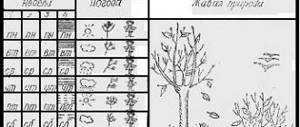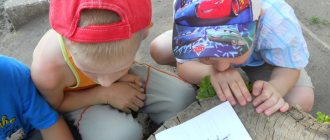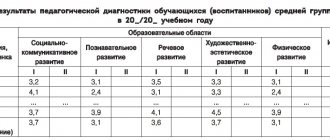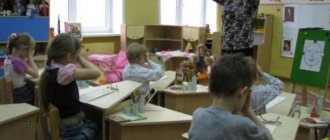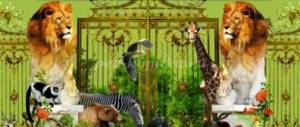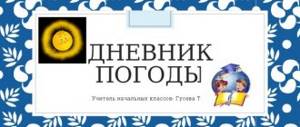Making a school weather diary
A weather observation diary for schoolchildren can be designed in different ways.
In the notebook
The notebook is a classic option. For such a diary you will need a squared notebook.
You can take an ordinary student’s notebook, but it will be more interesting to work in a large-format notebook: you can paste illustrations and photographs into it, draw graphs, and make notes.
The more colorful the design, the more interesting it will be for the young scientist to observe the weather.
A heading is made in the notebook with the name of the month and a table is drawn with the required number of columns. For example:
September weather observation table
| date | Air temperature | Precipitation | Atmosphere pressure | Wind power | Cloudiness | Notes |
- Air temperature values can be highlighted in different colors: shades of blue – cold temperature, shades of red – warm.
- In the “Precipitation” column, you can simply mark whether it is raining or snowing outside the window on such and such a day, or you can use colorful symbols or even stickers.
- In the “Clouds” column, the child can also show creativity, not just indicating the type of clouds, but making colorful sketches or even photographing the sky day by day.
- Notes can include interesting observations if something unusual is noticed on a particular day. For example, a bright rainbow or a strong thunderstorm.
The weather calendar for October, November, etc. is designed in a similar way.
In computer
A weather calendar for a schoolchild can be created on a computer. The advantage of this design is a more colorful weather diary, into which you can add any graphic images, graphs and much more. And children are more interested in working on a computer than writing in notebooks.
A similar table is created in a text document, into which data is then systematically entered.
In addition, there are many services for keeping weather diaries. You can download a special program that will offer an already developed and designed calendar with various background information and educational notes. The student will only need to enter the necessary data.
Other options
You can take a more creative approach to creating a weather calendar. There are many options.
You can hang whatman paper on the wall, decorate it colorfully, and think with your child about how best and more interesting to display weather data there.
You can take last year’s desk calendar with bright illustrations and paste lined sheets of paper onto the pages with numbers, where the child will enter his observations.
If your child loves handicrafts, you can help him design a calendar using decoupage, beads or embroidery, or even create knitted parts for him.
Imagination is not limited - the main thing is that the child is interested in this activity, and he understands why he is keeping this calendar.
Methodological recommendation “Organization of weather observations in lessons of the surrounding world”
Methodical recommendation
“Organization of weather observations in lessons about the surrounding world”
Khuler Tatyana Noozunovna
Primary school teacher at MBOU Kyzyl-Syldys secondary school.
The most important forms of organizing compulsory observations in nature, conducted in elementary school, are excursion lessons and extracurricular observations. In both cases, the supervision of observations is carried out by the teacher. In each of these forms, observations can be carried out individually, by groups of students, or by the whole class at the same time.
Extracurricular observations are carried out by schoolchildren starting from 2nd grade. At this stage, they are carried out mainly collectively with the direct participation of the teacher. Children observe the weather conditions as a whole class at the same time at the teacher's discretion. Based on observations, children immediately compose an oral story about the state of the weather.
During autumn, weather observations are not carried out every day. In September it can be 3-4 days in the second half of the month, in October 2-3 days in each week. In November and December, observations become more systematic: students observe the weather not of individual days, but of entire weeks, for example, the first and third weeks or the second and fourth. Days and weeks for observations are chosen by the teacher. In September and October these can be the days with the most pronounced signs of clear and cloudy weather.
Observations of air temperature throughout the year are carried out sporadically. 2nd grade students observe the air temperature not using a thermometer, but by feeling it, expressing it with the words “cold”, “warm”, “very cold”, etc. Therefore, these observations should be carried out on days with significant changes in air temperature, when children can compare their feelings of temperature on different days.
In grades 3 and 4, weather observations continue and are carried out daily throughout the year. At the same time, observations of cloudiness and precipitation are carried out throughout the day. Therefore, the weather characteristics of the day are compiled taking into account daily changes in cloudiness and precipitation. The thermometer readings are taken once a day, preferably between 12 and 13 hours. In autumn and spring, when there are severe frosts in the mornings and warm afternoons, students can take thermometer readings in the mornings on some days. Compare them and draw the appropriate conclusion, then this is included in the characteristics of the season.
The work of taking thermometer readings can be organized in different ways. Students do this on their own, at home. In this case, the temperature records are different. To accurately measure temperature, the thermometer must be in the shade.
In 3rd grade, children observe and note the presence of wind. This is done at a time specially allocated by the teacher. You can determine the wind by swaying trees, smoke from chimneys, etc.
In the 4th grade, children also observe the direction of the faith, which presents certain difficulties, since the wind can change it during the day. Therefore, observations of wind direction are carried out once a day at a time convenient for the teacher and students.
In grade 2, generalization of observations in nature is not provided for in the curriculum. Conversations are held about what the children saw. There is no need to explain the phenomena or reveal the reasons for what is happening. Conversations based on observations can be carried out in lessons with reading articles about nature, etc.
Students begin making special generalizations of observations from the 3rd grade. They briefly give a generalized description of the weather for a week, for a month. It is best to make these generalizations at the beginning of the lesson.
Who needs a schoolchild's weather forecast and why?
Keeping a diary of weather observations helps the child remember words characterizing scientific observations, that is, the student will better understand weather terms.
In addition, observation skills develop, the student begins to understand that all processes in nature are interconnected and cyclical. Gradually, the child will understand how weather forecasters predict the weather, how they know that the next day there will be rain or partly cloudy weather.
Such diaries also foster a love for nature, an understanding that people are part of nature and must understand the processes occurring in it.
Educational and methodological manual “Diary of observations of nature and human labor activity”
In the first days of September, the teacher asks second-year students about how they rested, what forest animals they saw, did they observe field work, did they complete their summer assignment? The drawings brought by the children are discussed in the group, and a small exhibition of the best drawings is organized. Based on conversations with children, excursions in early autumn, movies and art paintings, the signs of summer are fixed: sunny hot days, warm rains, green leaves, picking berries, etc. You should also continue to design the calendar. You can additionally give children some of the conventional, generally accepted signs for observing the weather. Signs of the seasons are supplemented according to the program and the development of students.
It is recommended to continue “reading” the calendar for the past day and week. When the concept of “week” is fixed, you can draw up a calendar for the month and, with the help of a teacher, conduct a generalization at the beginning of a new month. To design a monthly calendar, it is better to take a sheet of cardboard, at the top of which the inscription “Nature Calendar” is written, below the month and group are indicated. After this, the sheets for each day are placed in a certain sequence (sheets for the week are pasted in each row).
In December, with the establishment of winter, the teacher shows the children a sign:
Autumn months:
1. September. 2. October. 3. November.
Then the teacher attaches calendars for 3 months to the board. You can count how many rainy and sunny days there were in each month, and draw conclusions about what autumn was like this year. The teacher can ask the following questions: “What is the forest like in the fall? What happens to the trees? What did you find, besides leaves, under the oak, under the maple? What berries did you see on the mountain ash? How do people prepare for winter? How have the days become? For sketches and notes, margins 10-15 cm wide are left at the bottom and sides of the calendar.
In the second year of study, the calendar marks the drawings and entries of everything that was in the first year of study, and adds: the end of leaf fall, fog, severe frosts, snowstorms, thaw, the appearance of leaves, the arrival of birds, the first thunderstorm, ice drift, seasonal work in the garden and in the garden. For the summer, children are given a task: write down what birds they saw, collect and dry leaves and flowers.
In the second year of study, observations become more complex and expanded. The children are given the following concepts: clouds, clouds (it rains from the clouds), dew, fog, rain, hail. Children should know the names of the summer months and the signs of a thunderstorm. Additional symbols are posted on the board: “hail”, “dew”, “fog”, “thunderstorm”, “cloudy”. In the autumn months, children observe the position of the sun in the sky at different times of the day and get acquainted with autumn work in the field. The signs of the autumn months in the concept of pupils become more differentiated: the sky is gray, gloomy, cloudy, blue, blue, leaves are yellow, red, crimson, dry, light, fallen. In winter, the concept of “blizzard” is given, and children mark it on the calendar with arrows. The calendar marks all the phenomena that have been recorded and new ones are added: the last thunderstorm, the departure of rooks and starlings, freezing of a river, pond, ice drift, the last snowflakes, the last frost on the soil surface, the appearance of thawed patches, streams, the first cumulus clouds in the blue sky, the arrival of rooks , the beginning of swelling of buds in different plants, the first thunderstorm, the first thunder, the beginning of flowering of willow, buttercups, coltsfoot. Weather observations are made daily, and additions are made as interesting phenomena appear. For the summer, a task is given: collect useful plants, pebbles, shells, grow a flower in a pot, observe the behavior of fish, read some book about nature and at the end of August write a short essay of several sentences on the topic: “Where I was in the summer and what saw” (the most interesting thing I remember).
What do you need to keep a weather calendar?
To make it convenient for your young scientist to conduct his observations, make sure that you have the right tools in your home.
- Thermometer (ideally, both outdoor and indoor, but for the diary you will need an outdoor one). It is advisable not to hang the thermometer too close to a window or on the sunny side: then the temperature readings will be slightly too high.
- Barometer. This device is also installed outdoors and helps monitor atmospheric pressure.
- Precipitation gauge. Calculating the amount of precipitation is very simple. You need to place a small container outside where precipitation will collect during the day. Then pour the contents into a special measuring vessel, divide the resulting readings by 10. These actions will show the amount of precipitation in millimeters of the water layer.
- Weather vane and compass. These instruments are necessary to measure wind strength and direction. Armed with a compass, a child will certainly feel like a real scientist.
- Camera. Of course, weather observations can be carried out without it, but if it is possible to provide the child with a camera, the process will be much more interesting. The child, among other things, will learn to notice the beauty of nature: the magnificent patterns of clouds, the sparkling drops after rain, the unique colors of sunsets and sunrises.
Observing the weather is a very interesting and exciting process if organized correctly. Awaken in your child a love for nature and the processes occurring in it! Find time to help a schoolchild in this difficult task, direct his creative potential in the right direction, and - who knows - perhaps you will raise your child to be a young meteorologist or geographer!
Devices for measuring indicators
You can choose an unusual outdoor thermometer in the shape of an animal - this will make it much more interesting for your child to handle it
To maintain a weather calendar, special instruments are needed to obtain objective data:
- outdoor thermometer;
- compass;
- aneroid barometer (this device shows not only atmospheric pressure, but also air humidity);
- weather vane (to determine wind direction);
- precipitation gauge
If it is more or less clear with the first three devices - they are found in almost every home, then with the last couple some difficulties may arise. In order not to buy a weather vane, you can use the old proven method: we stand facing north, wet our finger and lift it up - on which side the finger dries faster - in that direction the wind blows. And if you have a light thin lath and a strip of tin, then you can make a weather vane with your own hands by attaching a tin arrow to the lath.
We use a small bucket as a precipitation gauge, which is filled with rainwater or snow per day. After this, pour the liquid into a measuring vessel and divide the indicator by 10 - this is the amount of precipitation in millimeters of the water layer.
weather diary
For gardeners and gardeners, the summer season begins in early spring, when the snow has not yet melted everywhere and the sun is not warm. But this year spring has been delayed, we can’t wait for real warmth. When going to the dacha with your children during this period, you should think about what to do with them.
Exciting fees
Preparing for a trip can be turned into a fun and educational game. Having talked about the seasons and their differences, you and your child need to make a list of things needed while staying at the dacha. Since the weather is still unstable, you will need warm clothes, rubber boots, and protection from the rain. We must not forget about the interests of the child. He will want to take his favorite books and toys, a paint book, and board games.
Mini vegetable garden
Children will be happy to set up their own vegetable garden on the windowsill. Use colored cardboard to give it a fun and colorful look. And experience in germinating beans or green feathers from bulbs will help you clearly and quickly see the appearance of sprouts. So, easily and imperceptibly, they will become acquainted with the basics of biology and physics.
Country affairs
There is always a lot of work on site:
— preparation of greenhouses and beds for planting seedlings;
- pruning bushes and trees;
- planting seedlings.
Older children can be involved in whitewashing trees, picking up trash, and planting berry bushes. They will be even more interested if the work contains elements of a game or competition.
Activities with children
Kids will be delighted with walks and games in the fresh air; they can be perfectly combined with educational activities. When walking with a child, you need to draw his attention to the beauty of awakening nature - the first flowers appearing from under the snow, swelling buds that will soon open into green leaves, the emerald green of breaking grass. Keeping an observation diary with sketches throughout the summer with his mother, the child will notice and compare the changes occurring in nature with the transition from season to season.
In rainy weather, you can play board games, draw, and solve riddles. Using simple examples of snow melting and a kettle boiling, children will become familiar with the different physical states of water.
If the sun is warm, the baby can be entrusted with a separate bed for independent care using mini-equipment. The boys will happily make birdhouses with their dad and hang them on trees, and after work they will proudly wash their hands at the Moidodyr washstand. A barbecue picnic on a holiday day will bring the whole family around the fire. The trip will leave a lot of happy memories in the child’s memory.
Here you can read more
Ancient weather calendar
Since ancient times, humanity has been observing weather changes and trying to predict important natural phenomena. The need to know the future weather was keenly felt by farmers, sailors, cattle breeders, travelers...
To systematize their observations of the changing world around us and identify the cyclical nature of natural phenomena, people created the first weather calendars. Back in the 5th century. BC e. Greek astronomer Meton exhibited marble tables in city squares with important weather phenomena and the dates of their observation. These tables were called parapegmama. They replaced modern weather forecasts for ancient people.
Weather calendars were compiled both in Ancient Rome (Columella calendar) and in India (local residents tried to predict the monsoon rainy season). However, the passion for calendars gained the greatest popularity in the Middle Ages.
The most famous works are The Book of Nature (1340) by Conrad Megenberg and The Shepherd's Rules of Banbury (1744), published by Sir Claridge, a member of the Royal Society of London. Along with a number of false statements, these calendars also had some substantiated signs. But more often than not the predictions were not confirmed. Of course, it is impossible to predict the weather... for example, based on the movement of celestial bodies, as Mauritius Knauer, who lived in the 17th century, did. at Langheim Monastery.
Be that as it may, the weather has been and remains one of the most important topics of conversation for people around the globe .
Fragment of the Bryusov calendar (1709–1715) with weather prediction for 100 years in advance.
